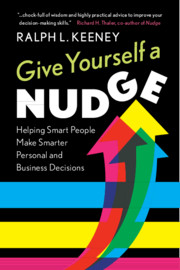Book contents
- Reviews
- Give Yourself a Nudge
- Give Yourself a Nudge
- Copyright page
- Dedication
- Contents
- Preface
- Acknowledgments
- 1 Nudge Yourself to Make Better Decisions
- 2 Your Decisions and Your Life
- 3 Making Value-Focused Decisions
- 4 Defining Your Decision
- 5 Identifying Your Values
- 6 Creating Alternatives
- 7 Identifying Decision Opportunities
- 8 Obtaining Authorization to Select Alternatives Controlled by Others
- 9 Becoming a Value-Focused Decision-Maker
- 10 Enhancing the Quality of Your Life
- 11 Useful Perspectives on Decision-Making
- Appendix Evaluating Alternatives and Making a Decision
- Notes
- Index
7 - Identifying Decision Opportunities
Published online by Cambridge University Press: 17 April 2020
- Reviews
- Give Yourself a Nudge
- Give Yourself a Nudge
- Copyright page
- Dedication
- Contents
- Preface
- Acknowledgments
- 1 Nudge Yourself to Make Better Decisions
- 2 Your Decisions and Your Life
- 3 Making Value-Focused Decisions
- 4 Defining Your Decision
- 5 Identifying Your Values
- 6 Creating Alternatives
- 7 Identifying Decision Opportunities
- 8 Obtaining Authorization to Select Alternatives Controlled by Others
- 9 Becoming a Value-Focused Decision-Maker
- 10 Enhancing the Quality of Your Life
- 11 Useful Perspectives on Decision-Making
- Appendix Evaluating Alternatives and Making a Decision
- Notes
- Index
Summary
The distinction between decision problems and decision opportunities is very important, but it is not recognized by most decision-makers. Decision problems are decisions that you must face as a result of others’ decisions and/or circumstances beyond your control. Decision opportunities, as I define them, are decisions that you create for yourself. You must reactively solve decision problems, but you can proactively pursue decision opportunities. When a decision problem occurs, it degrades one aspect of your quality of life. Therefore, the purpose of solving a decision problem is to get your quality of life back to where it was before the decision problem occurred. A thought about something that would make your quality of life today better is what stimulates the recognition of the decision opportunity. Pursuing it directly enhances the quality of your life. In addition, it often lowers the chances of certain unwanted decision problems occurring in the future and reduces the extent of the downgrading of your quality of life if they do occur. Guidelines for creating desirable decision opportunities are provided and illustrated with examples.
Keywords
- Type
- Chapter
- Information
- Give Yourself a NudgeHelping Smart People Make Smarter Personal and Business Decisions, pp. 117 - 140Publisher: Cambridge University PressPrint publication year: 2020

